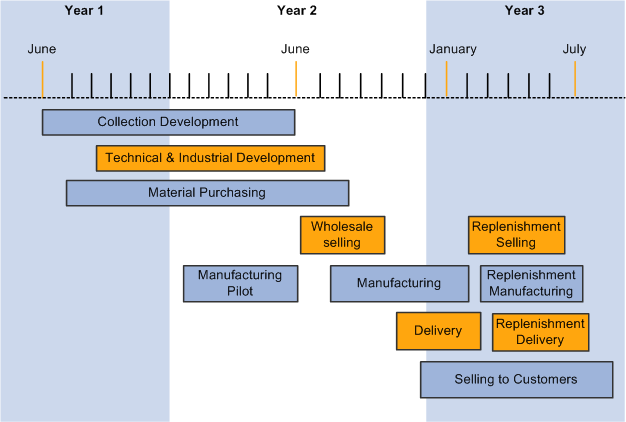Apparel Industry
The apparel industry is a highly competitive market that provides different items for different customers. The diverse profiles of apparel industry customers add complexity to the mix. Each customer has its own set of expectations, which must be met simultaneously.
Buying consumers in the apparel industry include men, women, and children.
An example of a style item in the apparel industry is jeans. Jeans have inside leg measurements, which allow the customer to benefit from a customized item at the price of ready-to-wear.
The apparel manufacturing industry has moved sharply towards a business model of design, marketing, and distribution. The typical time frame for an apparel item from concept to delivery is approximately two years. This diagram illustrates the product life cycle of apparel items:

The product life cycle begins with the design of apparel items. If collections are used, then collection development begins as well. Product and collection development encompass seasonal and permanent items.
The forecast generated for seasonal items is typically defined as a best-guess estimate based upon customer trends. You forecast at the item level and then drive planning down to material requirements planning (MRP) generation at the item level.
An item may start as a seasonal item, but the hope is that it will become a permanent item if possible. An example of a seasonal item is a swimsuit. It may be a seasonal item in one market, but may become a permanent item in a market that sells swimwear year round.
The forecast for permanent items is fairly standard. You forecast at the item level, which also drives MRP at the item level. The delivery of permanent items is in a short time frame. An example of a permanent item is jeans, which are available year round.
Technical and industrial development planning commences soon after apparel item development begins. The technical and industrial development phase entails the development of bills of material and routings required to manufacture items. This phase also includes the specification of machines required for production and determination of subcontracting requirements for outside operations.
Material purchasing activities acquire the necessary fabrics, zippers, buttons, and other items required to manufacture the apparel items. Blanket orders for purchasing are used because you know at the beginning that you will need a specific number of yards of fabric. You enter a blanket order with the supplier to reserve the material quantities needed, and then you release the purchase orders at different times to support the manufacturing process.
Approximately nine months into the development of apparel items, the pilot manufacturing run is performed.
At the end of the first year of development, wholesale selling begins. Manufacturing of the apparel items begins at the end of the development, planning, and purchasing phases. Delivery begins once manufacturing is underway. Delivery may be in a short time frame of four to six weeks to deliver all items.
The last phases involve the sale, manufacture, and delivery of replenishment items. If you have replenishment orders but you do not remanufacture, then you replenish with whatever items you have left.
The life cycle of permanent apparel items works a bit differently than seasonal collections because material is needed all the time.
Ready-to-wear apparel is made in standard sizes and available from merchandise in stock. The customer looks for characteristics such as style, color, and size when purchasing the ready-made items.
Children's ready-to-wear apparel supports a large number of sizes in the same item.
Examples of ready-to-wear apparel products include but are not limited to:
-
Socks and sockets.
-
Lingerie and beachwear.
-
Leather goods.
-
Costume jewelry.
-
Sporting attire.